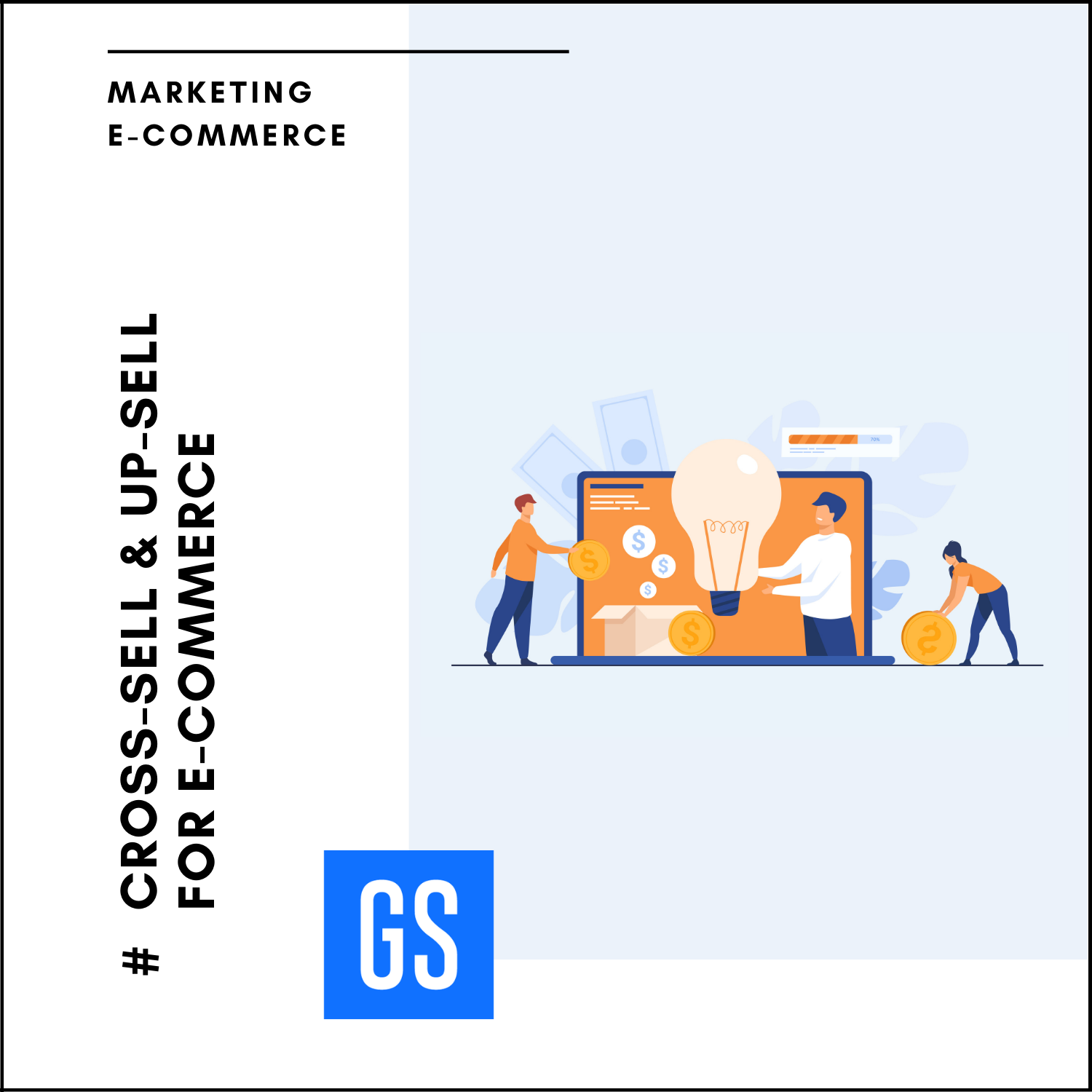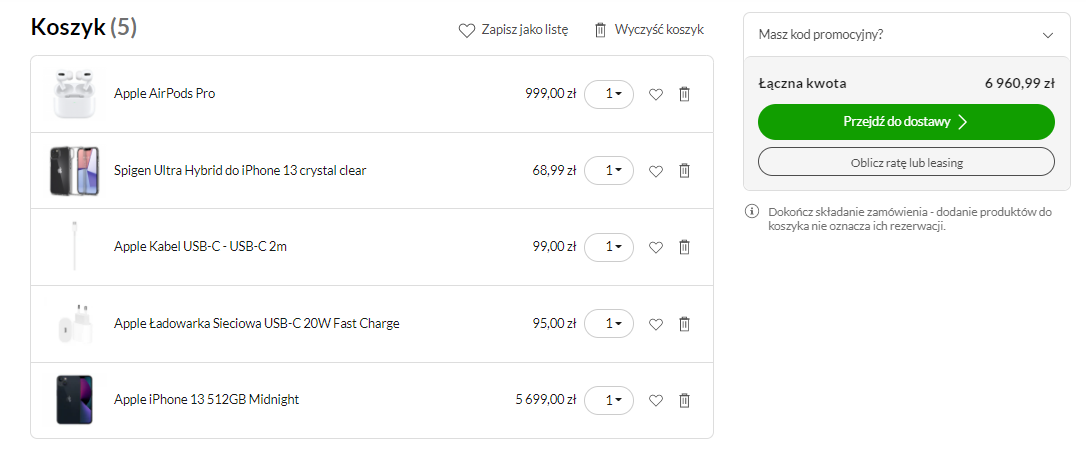One of the most popular additional methods for selling products in an online shop and thus increasing the value of orders is Cross – Selling and Upselling. In the following article we will discuss the main differences between these two methods. We will also go through examples of how these methods are used to sell products for various online shops in order to verify how the leaders in their industries do it. I cordially invite you to read on!
What is Cross-Selling in an online store?
Cross-Selling is about increasing the value of the basket by adding complementary products to the main – more expensive product. A good example would be the purchase of an iPhone. As we all know, Apple not only makes money by selling computers, phones and tablets, but the company’s strategy is also based on selling accessories that are usually compatible only with Apple brand products. In this case, it’s a well-thought-out strategy to increase brand revenue. Cross-Sell works in a similar way in the online store.
Surce: x-kom.pl
Apple iPhone 13 512GB Midnight
In this example, the main (most expensive) product is the IPhone. To be able to use it fully, we need a few accessories that will facilitate its use, everyday work, properly secure it or allow it to be loaded. This is one of the reasons why the seller (x-kom store) recommends at every stage to immediately buy an iPhone: charger, protective glass, protective case or headphones.
Surce: x-kom.pl
Recommended Cross-Selling accessories in the x-kom.pl store
Often, the leaders in the e-commerce industry, apart from the standard Cross-Selling on the product card, also have the option of adding complementary products to the main product at subsequent stages of the purchasing path. Below is an example of such an action in the x-com online store.
Surce: x-kom.pl
Recommended Cross-Selling accessories in the form of a pop-up after adding the product to the basket
After adding the main product to the cart, a pop-up with recommendations matching this iPhone model appears.
The last place where you can employ Cross-Selling is within the shopping basket. As you can see, at each stage, products are put under the nose to complement the main product. It seems to be a very simple functionality, and it can increase the value of the entire order by several dozen percent. 🙂
Surce: x-kom.pl
Recommended Cross-Selling accessories at the last shopping stage in the basket
Surce: x-kom.pl
Cart summary after adding the recommended products to the iPhone 13 main product
The total amount of the order: PLN 6,960.99
Main product price: PLN 5.699.00
Price of complementary products: PLN 1,261.99
Basket value increase: 22%
For the above case, sales increased by approximately 22%.
Source: Paul Rich
Cross-Sell section of watch straps matching the main StarDust watch product in the Paul-Rich online store.
What is Up-Selling in an online store?
Upselling, as opposed to Cross-Selling, differs in that we do not offer the customer an additional (complementary) product to match the main one, but only want to make them choose a different, usually more expensive product.
The use of Up-Selling can be found, for example, in computer equipment. For example through PPC (pay per click) campaigns we advertise a cheaper version of a very popular laptop. Thanks to this, we get a lot of traffic from potential customers on the product card. Thanks to previously prepared Up – Selling, we present customers with more expensive, richer versions of the same product. Consumers are often willing to pay more for a product that has a better technical specification than the cheapest equivalent.
In this case, it is also good practice to compare and detail the differences in the products and indicate exactly what the price difference is so that the potential customer feels the value in buying the more expensive version of the same product.
Surce: x-kom
Up-sell section of Apple MacBook Air M1 / 8GB / 256 / Mac OS Space Grey
For the above MacBook model, x-kom recommends more expensive versions of the same model. With more RAM and a larger internal disk. If other parameters are selected, the price of the product changes automatically.
Surce: eobowie.com.pl
Product card in the eobuwie.com.pl online store
Source: eobowie.com.pl
The Up-Sell section of the ARKK COPENHAGEN Sneakers
As can be seen above, in the Up-Selling section, related products were presented to the customer with products that are more expensive than those offered at the very beginning. The price of the main product is PLN 309.00, while the related products have a price of PLN 319.00 to PLN 399.00.
How to implement Cross-Selling and Up-Selling in an online store?
Cross-Selling is a very popular method of increasing the value of the basket, thus increasing sales. Hence, you can find a lot of ready-made solutions or applications.
For Open-Source eCommerce systems, Agencies or Software Houses should have ready-made (boxed) solutions that enable the Up-Selling and Cross-Selling module to be adapted to the current store. Ready-made applications can be used for SaaS engines. A few selected modules and applications are presented below. (These are selected solutions that I have used in the past or that have good user feedback on the internet).
Shopify Cross – Selling and Up – Selling (h3)
ReConvert Upsell & Cross Sell
https://apps.shopify.com/reconvert-upsell-cross-sell
Cross Sell & Cart Upsell
https://apps.shopify.com/cross-sell
There are many recommendation systems and Up-Sell Cross Sell modules. You can use external tools such as SALESmanago, Edrone, QuarticOn and dynamically display recommendations to users via API or built-in applications. There will be plenty of solutions for people willing to implement them. 🙂 I think that before we move to AI or Artificial Intelligence, it is worth taking care of basic recommendations tailored to a specific product and using simple applications or built-in functionalities of store systems.
Summary
The purpose of Cross-Sell and Up-Sell is to increase the value of the order. Cross-Selling works on the principle of matching the main product (more expensive) with complementary products – (cheaper). These are usually products that complement the main product in some way. In the case of a laptop it can be a computer case, a cloth, a mouse or a keyboard. In the case of Up-Selling, we are talking about replacing a cheaper product with a more expensive one at the purchase decision stage. For example, by directing traffic from product campaigns in the Google ad network to a cheap product, then through the Up-Sell section we try to convince the customer to order a more expensive variant of the same product. In the case of a laptop, there will be more RAM or disk space.
I hope you found the article helpful and it will better help you understand the difference between Cross-Selling and Up – Selling activities.
See also categories: Social Media in eCommerce | PPC Campaigns | Shopify technologies | eCommerce SEO | E-mail marketing | eCommerce project management | eCommerce marketing | eCommerce management | eCommerce development | eCommerce b2b | eCommerce automation | eCommerce analytics | Content marketing | Case Study eCommerce | News | Other












